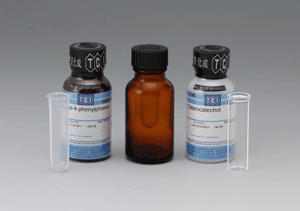APPLICATION
TCI Practical Example: Buchwald-Hartwig amination using a palladium catalyst and an alkylphosphine ligand
Used Chemicals
Aniline [A0463]
4-Chlorotoluene [C0297]
Bis(dibenzylideneacetone)palladium(0) (= Pd(dba)2) [B1374]
Sodium tert-Butoxide [S0450]
Tri-tert-butylphosphonium Tetrafluoroborate (= tBu3P·HBF4) [T2584]
Toluene
Procedure
Aniline (1.0 g, 10.7 mmol) and 4-chlorotoluene (1.4 g, 11.8 mmol) were dissolved in degassed toluene (10 mL) under nitrogen atmosphere. To this solution was added sodium tert-butoxide (1.54 g, 16.1 mmol), tri-tert-butylphosphonium tetrafluoroborate (31.1 mg, 0.1 mmol) and Pd(dba)2 (61.7 mg, 0.1 mmol, 1.5mol%). The reaction mixture was refluxed for 24 h and cooled to room temperature and quenched with H2O (10 mL). The organic phase was separated and washed with brine (10 mL), dried over MgSO4 (10 g), concentrated under reduced pressure to afford the crude product as a brown liquid. The crude product was purified by column chromatography on silica-gel (hexane : ethyl acetate = 95 : 5) to afford the desired product as a pale yellow crystalline solid (1.21 g, 6.6 mmol, 62%).
Experimenter’s Comments
Toluene was degassed by bubbling with N2 gas for 30 min.
The reaction mixture was analyzed by TLC (hexane : ethyl acetate = 1 : 1, Rf = 0.30) and GC.
Analytical Data (4-Methyl-N-phenylaniline)
1H NMR (400 MHz, CDCl3); δ 7.24-7.20 (t, J = 8.7 Hz, 3H), 7.07 (d, J = 8.7 Hz, 2H), 7.00-6.88 (m, 4H), 6.88-6.84 (m, 1H), 5.58 (s, 1H), 2.29 (s, 3H).
Lead Reference
Tetramethoxybenzene is a Good Building Block for Molecular Wires: Insights from Photoinduced Electron Transfer
L. G. Heinz, O. Yushchenko, M. Neuburger, E. Vauthey, O. S. Wenger, J. Phys. Chem. A 2015, 119, 5676.
Application
TCI Practical Example: Buchwald-Hartwig Amination Using Pd2(dba)3 and tBu3P・HBF4
Used Chemicals
4-Chloroanisole [C0122]
Diphenylamine
Tris(dibenzylideneacetone)dipalladium(0) (= Pd2(dba)3) [T2184]
Tri-tert-butylphosphonium Tetrafluoroborate (= tBu3P・HBF4) [T2584]
Sodium tert-Butoxide (= NaOtBu) [S0450]
Toluene
Procedure
To a 3-necked 300 mL round bottom flask was charged with diphenylamine (5.01 g, 29.6 mmol, 1.0 eq.), 4-chloroanisole (4.48 g, 31.4 mmol, 1.05 eq.) and degassed toluene (150 mL). To this solution was added Pd2(dba)3 (0.287 g, 0.131 mmol, 1 mol%), tri-tert-butylphosphonium tetrafluoroborate (0.198 g, 0.683 mmol, 2 mol%) and sodium tert-butoxide (6.34 g, 66.0 mmol, 2.2 eq.). The reaction mixture was refluxed for 16 hr under nitrogen atmosphere. After cooled to room temperature, the reaction was diluted with CH2Cl2 (300 mL). The suspension was filtered and the filtrate was dried over Na2SO4 and concentrated under reduced pressure to afford the crude and brown solid. The crude product was purified by silica-gel column chromatography (hexane/EtOAc = 99/1 then 8/1) to afford the light brown solid (7.0 g) containing 10 mol% of diphenylamine. Removal of the residual diphenylamine by recrystallization from hexane (55 mL, 60 °C then 15 °C) gave 4-methoxytriphenylamine as a white solid (5.26 g, 65 %).
Experimenter’s Comments
The reaction mixture was monitored by TLC (EtOAc/hexane = 1/10. Starting materials: Rf = 0.36 (diphenylamine), 0.59 (4-chloroanisole); target product: Rf = 0.46).
Analytical Data(4-Methoxytriphenylamine)
1H NMR (400 MHz, CD2Cl2); δ 7.26-7.17 (m, 4H), 7.10-6.98 (m, 6H), 6.98-6.91 (m, 2H), 6.89-6.82 (m, 2H), 3.79 (s, 3H).
13C NMR (101 MHz, CD2Cl2); δ 156.72, 148.56, 141.00, 129.39, 127.72, 123.12, 122.15, 115.05, 55.77.
Lead References
Air-Stable Trialkylphosphonium Salts: Simple, Practical, and Versatile Replacements for Air-Sensitive Trialkylphosphines. Applications in Stoichiometric and Catalytic Processes
M. R. Netherton, G. C. Fu, Org. Lett. 2001, 3, 4295.
An Air and Thermally Stable One- Component Catalyst for the Amination of Aryl Chlorides
D. Zim, S. L. Buchwald, Org. Lett. 2003, 5, 2413.
Other References
A Simple Catalytic Method for the Conversion of Aryl Bromides to Arylamines
A. Guram, R. Rennels, S. Buchwald, Angew. Chem. Int. Ed. 1995, 34, 1348.
Palladium-catalyzed synthesis of arylamines from aryl halides. Mechanistic studies lead to coupling in the absence of tin reagents
J. Louie, J. F. Hartwig, Tetrahedron Lett. 1995, 36, 3609.
Application
Air-stable Tri-tert-butylphosphone Equinalent



